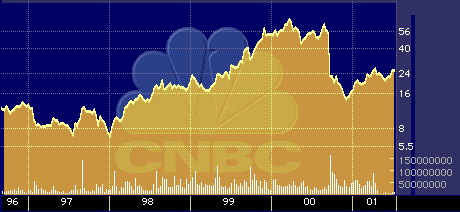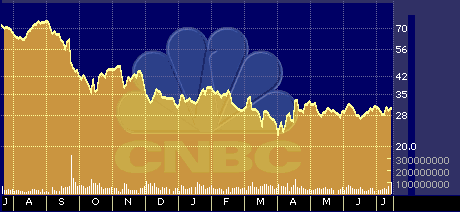
Apple’s New TV Campaign Targets Intel
Apple’s New TV Campaign Targets Intel
by Hal Plotkin
Silicon Valley Correspondent
Apple Computer Inc.’s {AAPL} new TV ads lampooning Intel might leave some investors worried that the world’s dominant microprocessor maker may be slipping.
But several key analysts say few PC buyers are likely to be swayed by the tough new Power Mac G4 TV ads, which ridicule Intel’s Pentium III chip.
“I don’t think the ads are going to move anyone off the Intel platform. It’s just a game of tit for tat,” says Tim Bajarin, an industry consultant who heads Creative Strategies Research International in Campbell, Calif. “You wait a few months, and Intel will be selling faster chips.”
Apple’s interim CEO, Steve Jobs, previewed his company’s newest anti-Intel TV ads at the Seybold trade show held this week in San Francisco. The commercials tout the fact that Department of Commerce regulations prevent Apple from selling the high-performance G4 in countries thought to pose a security risk to the United States.
“For the first time in history, a personal computer has been classified as a weapon,” the Apple ad says, going on to claim that Pentium computers, by comparison, “are harmless.” Apple’s G4 is powered by a microprocessor made by Apple, IBM {IBM}, and Motorola Inc. {MOT}.

AAPL 5-year stock price chart
Jobs showed the new TV ad twice shortly after putting the G4 through a side-by-side performance comparison with a 600-MHz Pentium III PC. In each of several on-stage demonstrations, Apple’s G4 speedily finished data-intensive tasks, while the Pentium III PC lagged far behind.
Jobs appeared on stage with longtime friend John Warnock, chairman and CEO of San Jose, Calif.-based Adobe Systems Inc., {ADBE} which makes the popular Photoshop image-editing application.
“You have to love these machines,” Warnock said as a beaming Jobs looked on. “Of all the machines we’ve seen, this is the fastest machine that runs our applications.” The G4 was particularly nimble with Photoshop, Jobs noted, because the computer’s hard disk comes loaded with special software, called a plug-in, designed specifically to speed up Adobe’s software.
While the crowd greeted Jobs G4 demo with enthusiasm, several analysts say his comparisons with Intel’s Pentium III were overblown.
“It was good showmanship,” says Martin Reynolds, vice president of Dataquest, based in San Jose, Calif. “But it was not good benchmarking.” The Intel PC used during the demo, for example, didn’t have the same software plug-in used by the G4. “I don’t have total confidence the comparisons were accurate,” Reynolds adds.
Bajarin also thinks Jobs may have overhyped the importance of the machine’s speed advantage but says Apple’s core customers will nonetheless welcome the G4. “It’s not going to do much to Intel,” he says. “But it is an important product for Apple because it appeals most to their highest-margin customers,” such as desktop publishers and heavy graphics users.
“Those customers are likely to say now is the time to upgrade to the new machine,” Reynolds agrees.
Apple still lags far behind Intel in the desktop PC market. The company controlled just 4.8 percent of the dollar market share during the second quarter, according to Dataquest. Intel-powered PC’s, by comparison, held more than a 90 percent market share during the same period.

INTC 52-week stock price chart
Several other factors, including the availability of compatible software, are at least as important as raw microprocessor speed when it comes to assessing the competitiveness of a desktop computer, analysts say.
“The really important comparison is the price-performance comparison,” says Charles Smulders, principal analyst at Dataquest. “In real terms, the industry is not as focused on performance right now. It’s more focused on sub-$1,000 PCs and smaller appliances.”
Apple’s new G4 is priced between $1,599 and $3,499, depending on how it’s configured. Starting in October, the company will also offer a companion 22-inch flat panel LCD display that can only be purchased with a G4, for an additional $3,999.
While the debate between Apple and Intel over processor speed will undoubtedly continue into the foreseeable future, Apple’s tactics at the San Francisco trade show left little room for doubt about which company has the most aggressive marketing team.
Ironically, attendees at the event heard pitches for Apple’s products at both the Apple and Intel trade show booths. Just moments after Jobs disparaged Intel’s chips on stage, Apple personnel were busy working inside the Intel booth conducting demos of Apple’s Quicktime streaming software on Intel-powered computers. There were, by contrast, no Intel personnel inside the far more-spacious and well-positioned Apple booth.
Warnock warmly congratulated Jobs on Apple’s marketing prowess. “The wonderful thing about having Apple back is this industry is no longer boring. Thank you, Steve,” he said to roaring applause.
Overall, the consensus was that Apple’s jabs at Intel will help spur progress at both companies.
“Strong competition is very healthy for the industry,” Smulders says. “But the real question is how strong a competitor Apple will be. Right now, it’s still very much a David and Goliath story.”


